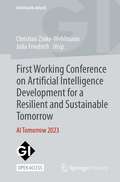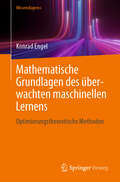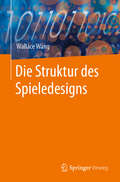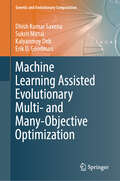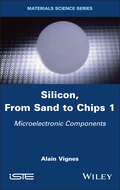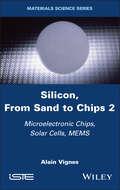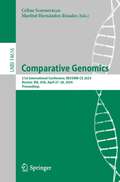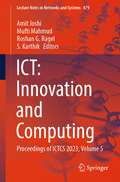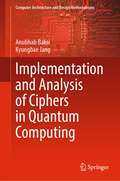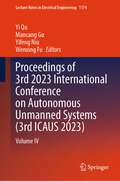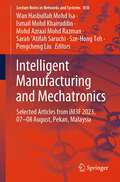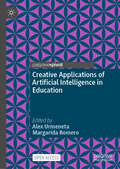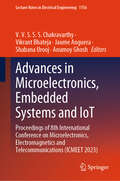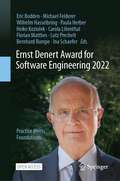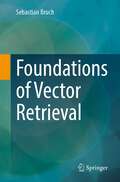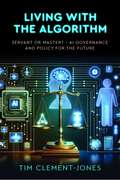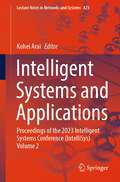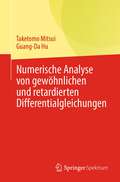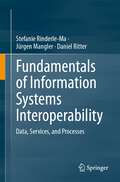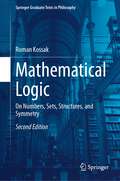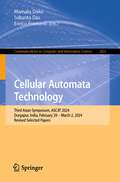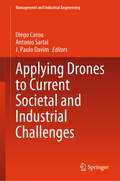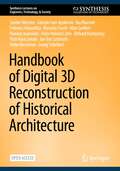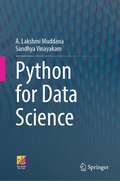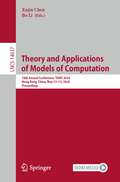- Table View
- List View
First Working Conference on Artificial Intelligence Development for a Resilient and Sustainable Tomorrow: AI Tomorrow 2023 (Informatik aktuell)
by Christian Zinke-Wehlmann Julia FriedrichKünstliche Intelligenz ist ein Treiber der digitalen Transformation von Unternehmen, welche die gesamte Organisation, einschließlich ihrer Strukturen, Prozesse und Mitarbeitender berührt.Die AI Tomorrow Konferenz möchte die menschzentrierte Perspektive auf KI und ihren nachhaltigen Einsatz, im ökologischen wie auch ökonomischen und sozialen Sinne, stärker ins Zentrum des wissenschaftlichen Diskurses rücken.Dies ist ein Open-Access-Buch.Der Inhalt: Die Autor:innen beleuchten Aspekte der KI-Entwicklung und des Einsatzes. Nach einer Einführung zu Resilienz und Nachhaltigkeit von KI erscheinen die Beiträge entsprechend ihrer Zuordnung zu den Konferenzsessions:(I) Digital transformation of organizations or processes through AI(II) Opportunities of AI for society(III) AI supported knowledge management and learning(IV) Manufacturing and factories of the futureDie Zielgruppe: Wissenschaftler:innen und Interessierte aus dem Bereich der Angewandten Informatik
Mathematische Grundlagen des überwachten maschinellen Lernens: Optimierungstheoretische Methoden
by Konrad EngelDieses Buch behandelt die gängigsten Methoden zur Klassifikation von digitalisierten Objekten. Jedem Objekt ist ein Punkt im Euklidischen Raum passender Dimension zugeordnet. Das Lernen basiert auf einer Menge von Punkten, für die die zugehörige Klasse bekannt ist. Eine Reduktion der Dimension sowie elementare und anspruchsvollere Methoden zur Ermittlung schnell berechenbarer Funktionen, mit denen man aus einem Punkt die zugehörige Klasse mit einer möglichst geringen Fehlerrate ableiten kann, werden hergeleitet und in einer einheitlichen Herangehensweise begründet. Die recht elementaren Beweise werden im Wesentlichen mit Mitteln der Linearen Algebra geführt, nur für die neuronalen Netze wird etwas Analysis benötigt.Die Produktfamilie WissensExpress bietet Ihnen Lehr- und Lernbücher in kompakter Form. Die Bücher liefern schnell und verständlich fundiertes Wissen.
Die Struktur des Spieledesigns
by Wallace WangDie Struktur des Spieledesigns soll angehenden und erfahrenen Spieleentwicklern helfen, ihre Ideen in funktionierende Spiele umzusetzen. Die Erstellung eines Spiels erfordert das Verständnis der grundlegenden Elemente aller Arten von Spielen, angefangen von papierbasierten Spielen bis hin zu den neuesten Videospielen. Durch das Verständnis, wie diese grundlegenden Prinzipien in allen Arten von Spielen funktionieren, können Sie dieselben Prinzipien anwenden, um Ihr eigenes Spiel zu entwerfen.Spiele handeln von Zielen, Struktur, Spiel und Spaß. Während jeder seine eigene Vorstellung davon haben wird, was "Spaß" sein könnte, kann jeder Spieleentwickler die Freude der Spieler maximieren, indem er bedeutungsvolle Entscheidungen anbietet, die verschiedene Risiken und Belohnungen mit sich bringen. Solche Herausforderungen, kombiniert mit Regeln und Einschränkungen, zwingen die Spieler, Hindernisse und Probleme mit verschiedenen Fähigkeiten wie Geschicklichkeit, Rätsellösung,Intelligenz und Strategie zu überwinden. Im Wesentlichen ermöglichen Spiele den Spielern, in neuen Welten voranzukommen und Probleme in einer sicheren, aber aufregenden Umgebung zu überwinden, die es ihnen ermöglicht, am Ende zu triumphieren.Genau wie das Spielen von Spielen weltweit bei allen Altersgruppen, Geschlechtern und Kulturen beliebt ist, erfreut sich auch das Game Design gleichermaßen großer Beliebtheit. Spiele können die Spieler herausfordern, den besten Zug zu machen, Rätsel zu lösen, sich im Kampf zu engagieren, Ressourcen zu verwalten und Geschichten zu erzählen. Indem man versteht, wie Zufall, Psychologie und Balance die Art und Weise beeinflussen können, wie Spiele gespielt werden, können die Leser entscheiden, welche Spielelemente am besten für ihre eigene Spielkreation geeignet sind.Ob Ihr Ziel darin besteht, Geld zu verdienen, etwas Neues zu lernen, eine soziale Aussage zu machen, eine bestehende Spielidee zu verbessern oder Ihre künstlerischen, programmierenden oder gestalterischen Fähigkeiten zu testen, kann das Game Design genauso viel Spaß machen wie das Spielen von Spielen. Indem Sie die Teile eines Spiels kennen, wie sie funktionieren, wie sie interagieren und warum sie Spaß machen, können Sie Ihr Wissen nutzen, um jede Idee in ein Spiel zu verwandeln, das andere spielen und genießen können.
Machine Learning Assisted Evolutionary Multi- and Many- Objective Optimization (Genetic and Evolutionary Computation)
by Dhish Kumar Saxena Sukrit Mittal Kalyanmoy Deb Erik D. GoodmanThis book focuses on machine learning (ML) assisted evolutionary multi- and many-objective optimization (EMâO). EMâO algorithms, namely EMâOAs, iteratively evolve a set of solutions towards a good Pareto Front approximation. The availability of multiple solution sets over successive generations makes EMâOAs amenable to application of ML for different pursuits. Recognizing the immense potential for ML-based enhancements in the EMâO domain, this book intends to serve as an exclusive resource for both domain novices and the experienced researchers and practitioners. To achieve this goal, the book first covers the foundations of optimization, including problem and algorithm types. Then, well-structured chapters present some of the key studies on ML-based enhancements in the EMâO domain, systematically addressing important aspects. These include learning to understand the problem structure, converge better, diversify better, simultaneously converge and diversify better, and analyze the Pareto Front. In doing so, this book broadly summarizes the literature, beginning with foundational work on innovization (2003) and objective reduction (2006), and extending to the most recently proposed innovized progress operators (2021-23). It also highlights the utility of ML interventions in the search, post-optimality, and decision-making phases pertaining to the use of EMâOAs. Finally, this book shares insightful perspectives on the future potential for ML based enhancements in the EMâOA domain.To aid readers, the book includes working codes for the developed algorithms. This book will not only strengthen this emergent theme but also encourage ML researchers to develop more efficient and scalable methods that cater to the requirements of the EMâOA domain. It serves as an inspiration for further research and applications at the synergistic intersection of EMâOA and ML domains.
Silicon, From Sand to Chips, Volume 1: Microelectronic Components
by Alain VignesSilicon is the material of the digital revolution, of solar energy and of digital photography, which has revolutionized both astronomy and medical imaging. It is also the material of microelectromechanical systems (MEMS), indispensable components of smart objects. The discovery of the electronic and optoelectronic properties of germanium and silicon during the Second World War, followed by the invention of the transistor, ushered in the digital age. Although the first transistors were made from germanium, silicon eventually became the preferred material for these technologies. Silicon, From Sand to Chips 1 traces the history of the discoveries, inventions and developments in basic components and chips that these two materials enabled one after the other. The book is divided into two volumes and this first volume is devoted to basic microelectronic components.
Silicon, From Sand to Chips, Volume 2: Microelectronic Chips, Solar Cells, MEMS
by Alain VignesSilicon is the material of the digital revolution, of solar energy and of digital photography, which has revolutionized both astronomy and medical imaging. It is also the material of microelectromechanical systems (MEMS), indispensable components of smart objects. The discovery of the electronic and optoelectronic properties of germanium and silicon during the Second World War, followed by the invention of the transistor, ushered in the digital age. Although the first transistors were made from germanium, silicon eventually became the preferred material for these technologies. Silicon, From Sand to Chips 2 traces the history of the discoveries, inventions and developments in basic components and chips that these two materials enabled one after the other. The book is divided into two volumes and this second volume is devoted to microelectronic and optoelectronic chips, solar cells and MEMS.
Comparative Genomics: 21st International Conference, RECOMB-CG 2024, Boston, MA, USA, April 27–28, 2024, Proceedings (Lecture Notes in Computer Science #14616)
by Celine Scornavacca Maribel Hernández-RosalesThis book constitutes the proceedings of the 21st International Conference on Comparative Genomics, RECOMB-CG 2024, which was held in Boston, MA, USA, during April 27–28, 2024. The 13 full papers presented in this book were carefully reviewed and selected from 21 submissions. The papers are divided into the following topical sections: phylogenetic networks; homology and phylogenetic reconstruction; tools for evolution reconstruction; genome rearrangements; and genome evolution.
ICT: Proceedings of ICTCS 2023, Volume 5 (Lecture Notes in Networks and Systems #879)
by Amit Joshi Mufti Mahmud Roshan G. Ragel S. KarthikThis book contains best selected research papers presented at ICTCS 2023: Eighth International Conference on Information and Communication Technology for Competitive Strategies. The conference will be held in Jaipur, India during 8 – 9 December 2023. The book covers state-of-the-art as well as emerging topics pertaining to ICT and effective strategies for its implementation for engineering and managerial applications. This book contains papers mainly focused on ICT for computation, algorithms and data analytics and IT security. The work is presented in five volumes.
Implementation and Analysis of Ciphers in Quantum Computing (Computer Architecture and Design Methodologies)
by Anubhab Baksi Kyungbae JangThis book deals with the upcoming threat that may be posed by quantum computers on modern-day security standards, particularly those involving symmetric key ciphers. Considering the progress in the field of quantum computing over the past few years, there is an ever-growing need to analyze the ciphers that are being employed in ensuring security. The symmetric key ciphers are generally considered safe against quantum computers, though one must consider the possible impact due to Grover's search algorithm (that reduces the security claim to the square root bound of what is expected against a classical computer). This book consolidates all the major research works in one place and presents it with adequate clarity, making the subject matter easy to understand for seasoned researchers and students alike. It covers the prerequisite information, new research works (including some of the state of the art), thought-provoking problems for further research, and all the relevant source codes. This book is interesting to engineers, researchers, and students who work/study in the field of cryptography.
Proceedings of 3rd 2023 International Conference on Autonomous Unmanned Systems: Volume IV (Lecture Notes in Electrical Engineering #1174)
by Yi Qu Mancang Gu Yifeng Niu Wenxing FuThis book includes original, peer-reviewed research papers from the 3rd ICAUS 2023, which provides a unique and engaging platform for scientists, engineers and practitioners from all over the world to present and share their most recent research results and innovative ideas. The 3rd ICAUS 2023 aims to stimulate researchers working in areas relevant to intelligent unmanned systems. Topics covered include but are not limited to: Unmanned Aerial/Ground/Surface/Underwater Systems, Robotic, Autonomous Control/Navigation and Positioning/ Architecture, Energy and Task Planning and Effectiveness Evaluation Technologies, Artificial Intelligence Algorithm/Bionic Technology and their Application in Unmanned Systems.The papers presented here share the latest findings in unmanned systems, robotics, automation, intelligent systems, control systems, integrated networks, modelling and simulation. This makes the book a valuable resource for researchers, engineers and students alike.
Intelligent Manufacturing and Mechatronics: Selected Articles from iM3F 2023, 07–08 August, Pekan, Malaysia (Lecture Notes in Networks and Systems #850)
by Wan Hasbullah Mohd Isa Ismail Mohd Khairuddin Mohd Azraai Mohd Razman Sarah 'Atifah Saruchi Sze-Hong Teh Pengcheng LiuThis book presents parts of the iM3F 2023 proceedings from the mechatronics as well as the intelligent manufacturing tracks. It highlights recent trends and key challenges in mechatronics as well as the advent of intelligent manufacturing engineering and technology that are non-trivial in embracing Industry 4.0 as well as addressing the UN Sustainable Development Goals. The book deliberates on conventional as well as advanced solutions that are utilized in the variety of mechatronics and intelligent manufacturing-based applications. The readers are envisaged to gain an insightful view on the current trends, issues, mitigating factors as well as solutions from this book. It provides a platform that allows academics as well as other relevant stakeholders to share, discuss, and deliberate their latest research findings in the field of manufacturing, mechatronics, and materials, respectively.
Creative Applications of Artificial Intelligence in Education (Palgrave Studies in Creativity and Culture)
by Alex Urmeneta Margarida RomeroThis open access book explores the synergy between AI and education, highlighting its potential impact on pedagogical practices. It navigates the evolving landscape of AI-powered educational technologies and suggests practical ways to personalise instruction, nurture human-AI co-creativity, and transform the learning experience. Spanning from primary to higher education, this short and engaging volume proposes concrete examples of how educational stakeholders can be empowered in their AI literacy to foster creativity, inspire critical thinking, and promote problem-solving by embracing AI as a tool for expansive learning. Structured in three parts, the book starts developing the creative engagement perspective for learning and teaching to then present practical applications of AI in K-12 and higher education, covering different fields (teacher education, professional education, business education) as well as different types of AI supported tools (games, chatbots, and AI assisted assessment). It also delves into the ethical considerations, policy implications, and the central role educators play in harnessing the power of an AI informed educational experience.
Advances in Microelectronics, Embedded Systems and IoT: Proceedings of 8th International Conference on Microelectronics, Electromagnetics and Telecommunications (ICMEET 2023) (Lecture Notes in Electrical Engineering #1156)
by V. V. S. S. S. Chakravarthy Vikrant Bhateja Jaume Anguera Shabana Urooj Anumoy GhoshThe book discusses the latest developments and outlines future trends in the fields of microelectronics, electromagnetics, and telecommunication. It contains original research works presented at the International Conference on Microelectronics, Electromagnetics and Telecommunication (ICMEET 2023), organized by Department of Electronics and Communication Engineering, National Institute of Technology Mizoram, India, during 6–7 October 2023. The book is divided into two volumes, and it covers papers written by scientists, research scholars, and practitioners from leading universities, engineering colleges, and R&D institutes from all over the world and shares the latest breakthroughs in and promising solutions to the most important issues facing today’s society.
Ernst Denert Award for Software Engineering 2022: Practice Meets Foundations
This open access book provides an overview of the dissertations of the five nominees for the Ernst Denert Award for Software Engineering in 2022. The prize, kindly sponsored by the Gerlind & Ernst Denert Stiftung, is awarded for excellent work within the discipline of Software Engineering, which includes methods, tools and procedures for better and efficient development of high quality software. An essential requirement for the nominated work is its applicability and usability in industrial practice. The book contains five papers that describe the works by Jannik Fischbach (Netlight Consulting GmbH and fortiss GmbH), who won the award, entitled Conditional Statements in Requirements Artifacts: Logical Interpretation, Use Cases for Automated Software Engineering, and Fine-Grained Extraction, Christian Kirchhof's (RWTH Aachen University) From Design to Reality: An Overview of the MontiThings Ecosystem for Model-Driven IoT Applications, Sven Peldszus's (Ruhr University Bochum) research about Security Compliance in Model-driven Development of Software Systems in Presence of Long-Term Evolution and Variants, Florian Rademacher's (RWTH Aachen University) work on Model-Driven Engineering of Microservice Architectures, and Alexander Trautsch's (University of Passau) Usefulness of Automatic Static Analysis Tools: Evidence from Four Case Studies. The chapters describe key findings of the respective works, show their relevance and applicability to practice and industrial software engineering projects, and provide additional information and findings that have only been discovered afterwards, e.g. when applying the results in industry. This way, the book is not only interesting to other researchers, but also to industrial software professionals who would like to learn about the application of state-of-the-art methods in their daily work.
Foundations of Vector Retrieval
by Sebastian BruchThis book presents the fundamentals of vector retrieval. To this end, it delves into important data structures and algorithms that have been successfully used to solve the vector retrieval problem efficiently and effectively. This monograph is divided into four parts. The first part introduces the problem of vector retrieval and formalizes the concepts involved. The second part delves into retrieval algorithms that help solve the vector retrieval problem efficiently and effectively. It includes a chapter each on brand-and-bound algorithms, locality sensitive hashing, graph algorithms, clustering, and sampling. Part three is devoted to vector compression and comprises chapters on quantization and sketching. Finally, the fourth part presents a review of background material in a series of appendices, summarizing relevant concepts from probability, concentration inequalities, and linear algebra. The book emphasizes the theoretical aspects of algorithms and presents related theorems and proofs. It is thus mainly written for researchers and graduate students in theoretical computer science and database and information systems who want to learn about the theoretical foundations of vector retrieval.
Living with the Algorithm: AI Governance and Policy for the Future
by Tim Clement-JonesAn authoritative guide to what is needed for AI governance and regulation from expert authors internationally involved in the practical world of AI. This book tackles the question of why AI is a distinct challenge from other technologies and how we should seek to implement innovation-friendly approaches to regulation. It sets out many of the risks to be considered, why regulation is needed, and the form this should take to promote international convergence on AI governance and the responsible deployment of AI. This is a highly readable prescription for AI governance and regulation designed to encourage the technological goals of humanity whilst ensuring that potential risks are mitigated or prevented and, most importantly, that AI remains our servant and does not become our master.
Intelligent Systems and Applications: Proceedings of the 2023 Intelligent Systems Conference (IntelliSys) Volume 2 (Lecture Notes in Networks and Systems #823)
by Kohei AraiThe book is a unique collection of studies involving intelligent systems and applications of artificial intelligence in the real world to provide solutions to most vexing problems. IntelliSys received an overwhelming 605 papers which were put under strict double-blind peer-review for their novelty, originality and exhaustive research. Finally, 227 papers were sieved and chosen to be published in the proceedings.This book is a valuable collection of all the latest research in the field of artificial intelligence and smart systems. It provides a ready-made resource to all the readers keen on gaining information regarding the latest trends in intelligent systems. It also renders a sneak peek into the future world governed by artificial intelligence.
Numerische Analyse von gewöhnlichen und retardierten Differentialgleichungen
by Taketomo Mitsui Guang-Da HuDieses Buch dient als prägnantes Lehrbuch für Studenten in einem fortgeschrittenen Undergraduate- oder First-Year-Graduate-Kurs in verschiedenen Disziplinen wie angewandte Mathematik, Steuerung und Ingenieurwesen, die den modernen Standard der numerischen Methoden von gewöhnlichen und verzögerten Differentialgleichungen verstehen wollen. Experten in denselben Bereichen können sich auch über die jüngsten Entwicklungen in der numerischen Analyse solcher Differentialsysteme informieren. Gewöhnliche Differentialgleichungen (ODEs) sind ein starkes mathematisches Werkzeug, um eine Vielzahl von Phänomenen in Wissenschaft und Technik auszudrücken. Neben ihrer eigenen Bedeutung ist eine der mächtigen Richtungen, in die sich ODEs ausdehnen, die Einbeziehung einer unbekannten Funktion mit verzögertem Argument. Dies wird als verzögerte Differentialgleichungen (Delay differential equations, DDEs) bezeichnet, die häufig in der mathematischen Modellierung vonBiologie, Demographie, Epidemiologie und Kontrolltheorie vorkommen. In einigen Fällen kann die Lösung einer Differentialgleichung durch algebraische Kombinationen bekannter mathematischer Funktionen erhalten werden. In vielen praktischen Fällen ist eine solche Lösung jedoch recht schwierig oder nicht verfügbar, und es sind numerische Näherungen erforderlich. Die moderne Entwicklung von Computern beschleunigt die Situation und eröffnet darüber hinaus mehr Möglichkeiten der numerischen Mittel. Die Kenntnis und das Fachwissen über die numerische Lösung von Differentialgleichungen wird nun in weiten Bereichen der Wissenschaft und des Ingenieurwesens vorausgesetzt.Man könnte meinen, dass ein gut organisiertes Softwarepaket wie MATLAB in etwa die gleiche Lösung bietet. In gewisser Weise stimmt das auch, aber man muss bedenken, dass der blinde Einsatz von Softwarepaketen den Benutzer in die Irre führt. Das Wesentliche der numerischen Lösung von Differentialgleichungen muss noch gelernt werden. Das vorliegende Buch soll das Wesentliche der numerischen Lösungen von gewöhnlichen Differentialgleichungen sowie von Verzögerungsdifferentialgleichungen vermitteln. Die Autoren haben insbesondere festgestellt, dass es noch wenige prägnante Lehrbücher über Verzögerungsdifferentialgleichungen gibt, und haben sich dann daran gemacht, die Lücke durch möglichst transparente Beschreibungen zu schließen. Die wichtigsten Algorithmen zur numerischen Lösung sind in diesem Buch klar beschrieben. Auch die Stabilität von Lösungen von ODEs und DDEs ist von entscheidender Bedeutung. Das Buch führt in die asymptotische Stabilität von analytischen und numerischen Lösungen ein und bietet einen praktischen Weg zur Analyse ihrer Stabilität unter Verwendung einer Theorie komplexer Funktionen.
Fundamentals of Information Systems Interoperability: Data, Services, and Processes
by Stefanie Rinderle-Ma Jürgen Mangler Daniel RitterThis book presents fundamental concepts and technologies to tackle interoperability between information systems. It details interoperability at the data, service, and process level, and combines theoretical foundations with hands-on presentation of technologies to enable the development of sound and practical integration. Chapter 1 details general interoperability challenges and describes the structure of the book. To start with, Chapter 2 presents technologies for the exchange of data between two selected and highly relevant data formats, i.e., relational databases and XML. Next, Chapter 3 explains concepts for schema matching and mapping and data integration as well as the technological basis for implementing them based on query and transformation languages like XPath and XSLT. Chapter 4 then turns to service interoperability and explains two related technologies – REST and GraphQL – in detail. In Chapter 5, fundamentals for designing process orchestrations at the conceptual level are presented, focusing on how to model process orchestrations and how to verify their correctness and soundness, and showing BPMN as the de facto modeling standard. Chapter 6 then details the concepts and languages for the implementation of process orchestrations, including the presentation of execution languages for process orchestrations that are equipped with a formal semantics, e.g., Workflow Nets, the Refined Process Structure Tree, and CPEE Trees. Subsequently, Chapter 7 focuses on the growing number of distributed, loosely coupled, and often non-interoperable applications through the concepts of enterprise application integration and explains these by an implementation in CPN Tools and by two case studies. Eventually, Chapter 8 is lifting the orchestration and integration concepts and technologies to the choreography level by dealing with the interoperability between different process orchestrations. Chapter 9 concludes the book by featuring success factors for interoperability projects. It also provides a range of open research directions for interoperability such as compliance, sensor fusion, and blockchain technologies. The book is mainly intended as a textbook to be used for developing and teaching courses on interoperability and integration. To this end, it is accompanied by a Web site with additional teaching materials. It also spans a bridge from researchers to graduate students and practitioners by providing a deep understanding on practical interoperability challenges and solutions. The focus here is put on de facto standards and open-source systems and tools to enable interoperability solutions at low cost.
Mathematical Logic: On Numbers, Sets, Structures, and Symmetry (Springer Graduate Texts in Philosophy #4)
by Roman KossakThis textbook is a second edition of the successful, Mathematical Logic: On Numbers, Sets, Structures, and Symmetry. It retains the original two parts found in the first edition, while presenting new material in the form of an added third part to the textbook. The textbook offers a slow introduction to mathematical logic, and several basic concepts of model theory, such as first-order definability, types, symmetries, and elementary extensions. Part I, Logic Sets, and Numbers, shows how mathematical logic is used to develop the number structures of classical mathematics. All necessary concepts are introduced exactly as they would be in a course in mathematical logic; but are accompanied by more extensive introductory remarks and examples to motivate formal developments. The second part, Relations, Structures, Geometry, introduces several basic concepts of model theory, such as first-order definability, types, symmetries, and elementary extensions, and shows how they are usedto study and classify mathematical structures. The added Part III to the book is closer to what one finds in standard introductory mathematical textbooks. Definitions, theorems, and proofs that are introduced are still preceded by remarks that motivate the material, but the exposition is more formal, and includes more advanced topics. The focus is on the notion of countable categoricity, which analyzed in detail using examples from the first two parts of the book. This textbook is suitable for graduate students in mathematical logic and set theory and will also be of interest to mathematicians who know the technical aspects of the subject, but are not familiar with its history and philosophical background.
Cellular Automata Technology: Third Asian Symposium, ASCAT 2024, Durgapur, India, February 29–March 2, 2024, Revised Selected Papers (Communications in Computer and Information Science #2021)
by Mamata Dalui Sukanta Das Enrico FormentiThis book constitutes the refereed conference proceedings of the Third Asian Symposium on Cellular Automata Technology, ASCAT 2024, held in Durgapur, India, during February 29 - March 2, 2024.The 15 full papers presented in this book were carefully reviewed and selected from 33 submissions. The symposium aims to explore the latest advancements, methodologies, and interdisciplinary connections that showcase the versatility and potential impact of cellular automata in contemporary research.
Applying Drones to Current Societal and Industrial Challenges (Management and Industrial Engineering)
by Diego Carou Antonio Sartal J. Paulo DavimThis book explores drone applications and the cutting-edge technologies that drive their functionality. From transforming everyday challenges like traffic congestion to enhancing efficiency in fields such as search and rescue operations, protection of critical infrastructure, and medicine, the book explores how drones serve as powerful allies to address diverse human needs. The chapters not only showcase the applications of drone technology but also shed light on how these vehicles can revolutionize commonplace tasks, such as delivering packages with unprecedented efficiency. The book also explores technological intricacies, regulatory considerations, and the evolving demands of today's consumers. By providing a holistic view, it equips readers with a deep understanding of the multifaceted landscape surrounding drone technology.
Handbook of Digital 3D Reconstruction of Historical Architecture (Synthesis Lectures on Engineers, Technology, & Society #28)
by Sander Münster Fabrizio Ivan Apollonio Ina Bluemel Federico Fallavollita Riccardo Foschi Marc Grellert Marinos Ioannides Peter Heinrich Jahn Richard Kurdiovsky Piotr Kuroczyński Jan-Eric Lutteroth Heike Messemer Georg SchelbertThis open access book is a handbook for students, experts and interested parties who want to learn more about digital 3D reconstruction of historical architecture. The book provides answers to the core questions of the subject: What is a digital 3D model or a digital 3D reconstruction? How are they created and what are they used for? Practical instructions, condensed knowledge, explanations of technical terms and references to example projects, literature and further references provide information of varying density and thus enable an individual introduction to the subject.The book combines extensive knowledge on the topic of "digital 3D reconstruction of historical architecture" and provides practical instructions for independent implementation. Up to now, there has been no cross-disciplinary vocabulary for technical terms in this field, so this publication makes a start.The book is aimed at students, experts in the field and the interested public and offers various possibilities for the different target groups to delve deeply into the subject.The book was created within the research network "Digital 3D Reconstruction as Tools for Research in Architectural History," which was funded by the German Research Foundation (DFG) from 2018 to 2023. The authors combined their expertise in the fields of art and architectural history, architecture, university teaching and media informatics.
Python for Data Science
by A. Lakshmi Muddana Sandhya VinayakamThe book is designed to serve as a textbook for courses offered to undergraduate and graduate students enrolled in data science. This book aims to help the readers understand the basic and advanced concepts for developing simple programs and the fundamentals required for building machine learning models. The book covers basic concepts like data types, operators, and statements that enable the reader to solve simple problems. As functions are the core of any programming, a detailed illustration of defining & invoking functions and recursive functions is covered. Built-in data structures of Python, such as strings, lists, tuples, sets, and dictionary structures, are discussed in detail with examples and exercise problems. Files are an integrated part of programming when dealing with large data. File handling operations are illustrated with examples and a case study at the end of the chapter. Widely used Python packages for data science, such as Pandas, Data Visualization libraries, and regular expressions, are discussed with examples and case studies at the end of the chapters. The book also contains a chapter on SQLite3, a small relational database management system of Python, to understand how to create and manage databases. As AI applications are becoming popular for developing intelligent solutions to various problems, the book includes chapters on Machine Learning and Deep Learning. They cover the basic concepts, example applications, and case studies using popular frameworks such as SKLearn and Keras on public datasets
Theory and Applications of Models of Computation: 18th Annual Conference, TAMC 2024, Hong Kong, China, May 13–15, 2024, Proceedings (Lecture Notes in Computer Science #14637)
by Xujin Chen Bo LiThis book constitutes the proceedings of the 18th Annual Conference on Theory and Applications of Models of Computation, TAMC 2024, which was held in Hong Kong, China, during May 13–15, 2024. The 30 full papers presented in this book were carefully reviewed and selected from 69 submissions. The main themes of the selected papers are computability, complexity, algorithms, information theory, as well as their integration with machine learning theory and the foundations of artificial intelligence.
